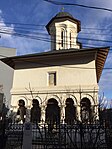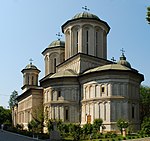Bulevardul Unirii
Europe road stubsRomania geography stubsRomania transport stubsStreets in Bucharest

Bulevardul Unirii (Romanian: [buleˈvardul uˈnirij], Union Boulevard) is a major thoroughfare in central Bucharest, Romania. It connects Constitution Square (Piața Constituției) with Alba Iulia Square (Piața Alba Iulia), and also runs through Union Square (Piața Unirii). The Constitution Square end features the Palace of the Parliament, which began construction simultaneously with the boulevard as an architectural unit.
Excerpt from the Wikipedia article Bulevardul Unirii (License: CC BY-SA 3.0, Authors, Images).Bulevardul Unirii
Unirii Boulevard, Bucharest Centrul Civic (Sector 3)
Geographical coordinates (GPS) Address Nearby Places Show on map
Geographical coordinates (GPS)
| Latitude | Longitude |
|---|---|
| N 44.426388888889 ° | E 26.112777777778 ° |
Address
Unirii Boulevard 43-45
030824 Bucharest, Centrul Civic (Sector 3)
Romania
Open on Google Maps











